The very mention of St. David’s had been making me shudder for months. This was ever since the unwelcome discovery that the cathedral there is a proud member of the Anglican club, and would therefore require a lick. Yet another arduous journey would have to be endured, this time to a remote tip of west Wales I was totally unfamiliar with.
I had made my first proper trip to Wales the previous month for an enjoyable if uneventful day-trip to Cardiff and Newport. Wales’s capital city is a true delight, as is its cathedral at Llandaff. Here I passed a happy afternoon in this semi-rural suburb, exploring (and licking) my first Welsh cathedral. The most pleasing discovery of that day was that a young Roald Dahl had grown up nearby and had attended the cathedral school. The famous sweet shop of dead mouse notoriety is still standing, and is now a chippie.
St. Woolos’s Cathedral in Newport is another gem, sat on top of a hill overlooking the town. Here I met a friendly caretaker, who over a cup of tea told me of the financial difficulties unknown cathedrals like this suffer with. He showed me around the building and spoke eloquently about its treasures, chief of which is a beautiful Norman arch from the original, early Medieval church. Over more tea and biscuits he told me, with some sadness in his voice, that I had been the only visitor that day. If you ever find yourself in Newport, do stop by the cathedral and have a look. It’s a charming place and the biscuits are to die for.
The journey to St. David’s would be far less enjoyable – if anything it promised to be truly hellish. Sitting on the very western tip of Wales, the city (for that is what this tiny village has been since 1995) is a right royal pain to get to. The nearest railway station is 16 miles away, in the sleepy town of Haverfordwest. A train journey here would have been convenient were it not for the outrageous fare and total of 5 different changes, including a 3 hour wait in Swansea in the dead of night. The other, far cheaper option was to take a Megabus as far is it would go in a generally western direction. This would leave me in Pembroke Dock, only an hour or so from St. David’s by road. This seemed a splendid solution, the only drawback being that the coach would dump me there at one o’clock in the morning, six hours before the first bus. During my teenage years the prospect of ending up in some unknown town at such an hour had been thrilling; an adventure of boundless opportunity and character-building experiences. Now aged 27 and the recipient of one assault, two muggings and a nasty incident with a hungry stag I thought differently. As the bus edged ever closer to my destination the more scared I became. The now familiar feeling of foolishness returned: just what the hell was I was doing? The matter of where I would spend the night was another question that dogged my thoughts on that unhappy journey westwards.
I’d expected Pembroke Dock to be grim, and grim it was. The bus was a haven of comfort and warmth compared to the damp world of portakabins and dead seagulls outside, into which myself and four other wretched passengers were now unceremoniously dumped. I watched the coach disappear into the night and considered the options: either sleep in the ferry terminal or commit a crime to get a bench in a Police cell. There was also a hospital nearby – maybe if I inflicted an injury upon myself (which seemed a likely outcome given my state of mind at the time) there would be a place to rest my head. In the end I chose the ferry terminal, mainly because they sold cups of Bovril and had a TV.
The terminal was quite cosy it turned out, and virtually empty. Just as I was about the settle down for the night however, a smug sign informed me that the building would be closing at 2.45 am when the ferry from Ireland arrived. Drat. Surprisingly, the Bovril offered absolutely no comfort to this crushing news. Forming a new plan, it seemed wisest to get as much sleep as possible before being chucked out. I curled up on a hard bench therefore and indulged in self-pitying melancholy.
A lady’s soft voice woke me up:
“Are you getting the ferry, love?”
I swung off the bench with a start and made her yelp. She held a walkie-talkie and looked ready to call security, but thankfully she waited patiently and listened to my tale of woe. If I could just put my head down somewhere dry and warm until morning, I cried, then all would be well.
“There might be a place nearby where you can kip for tonight, just a minute darling” she said sympathetically, before speaking a few rapid Welsh sentences into the walkie-talkie. For all I knew she could have just sent an order to release a pack of wolves on me, but her smile betrayed a sweetness that raised my spirits.
A few minutes later a jeep pulled up outside and a hand beckoned me to jump in. Another kindly lady drove me to large portakabin in a distant corner of the dock. This, it turned out, was a rest stop for lorry drivers and was a veritable paradise. Inside were soft sofas, radiators and enough tea and coffee to swim in. Better still, a plasma screen TV provided some light entertainment as my eyes finally began to feel heavy.
I slept like a baby and was not even woken by the fierce rainstorm that lashed Wales that night, which would surely have washed me into the sea had I not been so lucky in finding this truckers’ palace. I emerged into the early morning refreshed and with a renewed faith in humankind. This feel-good factor increased when another port official offered me a lift all the way to Haverfordwest. The kindness and decency of the people of Pembroke Dock will never be forgotten.
From Haverfordwest I took the local bus to St. David’s. The route hugs the seashore in several places and offers a wonderful introduction to the famously beautiful Pembrokeshire coast. Coves of sandy beaches are plentiful here, and are a haunt for early morning surfers, who skimmed merrily along the tops of raging waves. The sun was returning too, and bathed the beaches in a romantic dawn glow.
St. David’s sits at the heart of all this beauty, almost on the tip of a peninsula jutting out into the Irish Sea. It’s a gorgeous little place full of charming cottages and old winding streets. It is difficult to believe, however, that this tiny collection of houses and shops constitutes a city.
The cathedral vs. city debate had been a popular one during conversations about the bet. There were those who maintained that any settlement that could boast a cathedral was, by law, a city and those who didn’t really give a damn either way. Although it is true that many places – such as Truro and Chelmsford – are cathedral cities, they did not gain their city status simply by having a bishop’s church within their limits. This had indeed been the law ever since Henry VIII had famously moved England’s religious goalposts so that he could bonk Anne Boleyn, but in 1888 this ruling was finally abolished.
If this was the case, what happened at St. David’s? It turns out the city council had been pretty miffed about their home being demoted, and in 1991 first mooted the idea of joining the top table once more. The matter went before the Queen, who in 1994 granted both St. David’s and Armagh in Northern Ireland city status “In recognition of their important Christian heritage and their status as cities in the last century.” The theme continued this year when another Welsh cathedral town, St. Asaph (still to be licked), joined the club along with Chelmsford and Perth as part of the Diamond Jubilee feel-good factor.
I must sat that I rather enjoyed that fact that this tiny village, with a population of barely 1,600 is (officially speaking) a city. The likes of Reading (232,600), Dudley (195,000) and Luton (186,000) have all tried and failed in recent years, which is a jolly thought.
After a delicious breakfast in a friendly establishment on the High Street I made my way, burping, down to the cathedral. It sits in the sheltered valley of Glyn Rhosyn, through which a little rivers runs, giving the area its luscious greenery and the calming sound of running water.
This is the site of the monastic community first founded by St. David himself back in the 6th-century, and is the beating heart of Welsh Christianity. Nearby are St. Non’s Well and the holy place, once “bathed in brilliant light” where Wales’s patron saint is said to have been born. The ruins of the bishop’s palace complete the splendid scene, that was now bathed in glorious morning sunshine.
Despite its peaceful air, the site has taken its fair share of batterings by raiders over the centuries. Chief amongst these were the Vikings, who even saw fit to murder two of the local bishops in 999 and 1080, the rotters. William the Conqueror (himself a descendant of a Viking warlord) later visited St. David’s to pray and was quite taken by the place. The same was true of his son, the future King Henry I, who called for a new stone cathedral to be built here in the early 12th-century. Under Bishop Bernard the monastic community flourished, and in 1123 a Papal Privilege was bestowed upon the cathedral, decreeing that “two pilgrimages to St. David’s is equal to one to Rome, and three pilgrimages to one to Jerusalem.” Quite an honour indeed.
As with the majority of cathedrals in the British Isles, further additions and modifications were made to the building over the following centuries, with a few collapsed towers, a tornado and even an earthquake providing their own special input into the design we see today. New raiders, this time in the form of Cromwell’s soldiers (not them again), also looted a great deal of the cathedrals treasures during the years of the Puritan Commonwealth of the mid 1600s, and so began a long period of decline.
It was not until the 1950s that new life was breathed into the cathedral, when the young and energetic Reverend Carl Witton-Davies was appointed as dean. His enthusiasm gave rise to the famous Welsh Youth Pilgrimages to St. David’s, which helped to inspire a whole new generation of clergy in the country. The much abused and neglected cathedral was thus reborn.
Given that St. David’s has been on the receiving end of so much grief in the past, the level of calmness and serenity surrounding the place is startling. I was just one of hundreds of visitors milling around that day, and we shuffled about in quiet awe at the beauty of it all. Even a group of French teenagers – notorious for their boisterous ways – maintained a level of hushed respect that was admirable.
The ornate vaulted ceiling of the main tower was one of many highlights and is well worth a painful crane of the neck to view in all its splendour. Nearby is is the 13th-century shrine of St. David, the focus of pilgrimages even today. Close to this another pilgrimage of sorts was being made at the tomb of Edmund Tudor, grandfather of (yes, you’ve guessed it) Henry VIII. Middle-Aged American women bustled around this with an air of reverence, trying to recall whether the man inside the lovely stone box had appeared on the TV series The Tudors. This famous royal dynasty have become quite popular over the last few years it seems, despite their strong penchant for killing and persecuting people in imaginative ways and displaying their heads on pikes; what times they were!
The Tudor-perverts went into spasm upon stepping foot into the Holy Trinity Chapel. Here the coat of arms of the dynasty’s founder, Henry VII, are proudly displayed on the fine fan-vaulted ceiling. Henry had been born not too far from here in 1457, at the imposing Pembroke Castle, so the multitude of references to his family here were hardly surprising.
Increasing numbers of coach parties continued to arrive all morning and eventually the peace and quiet was lost. The general hubbub also made me uneasy, as it meant that the all-important lick might well be witnessed. I had come to realise now that no one was really offended if I licked a cathedral, it was just bloody embarrassing being spotted doing it. The memory of Rochester – when an avid crowd had gathered to watch me do the deed – still haunted me, and I had made a vow to never ask a stranger to take a licking-photo again.
So, I spent a good hour retracing my steps through the cathedral looking for a quiet spot to get the job done, but everywhere was brimming with visitors. Even in the quieter corners some boob would suddenly appear just as I had got into position and ruin everything. Memories of Chichester returned and how I had prayed for a bottle of chloroform and a flannel to deal with these people.In the end I used the Birmingham Cathedral tactic and filmed the lick instead. I do much prefer a photo of course, but it was not to be. I was pleased though to get the small statue of St. David in shot, however.
After so much anguish and trouble getting here it was a huge relief to get this one finally done. To celebrate I decided to stay the night in St. David’s and enjoy its many charms, including the fabulous coastline nearby. Unfortunately my enquiries revealed that there was not a bed to be had in the whole city for the next few days, so full was the place with holiday-makers. Indeed, the High Street was now alive with them, and suddenly it had resembled Padstow or Salcombe, both popular weekend retreats for wealthy London folk. A little dejected I caught the next bus out of town and began a long and uncomfortable journey east to go lick yet another cathedral.
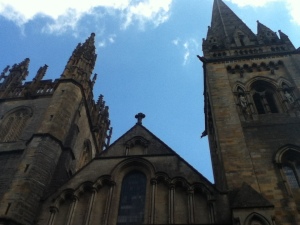
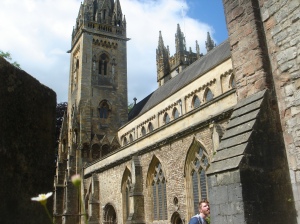
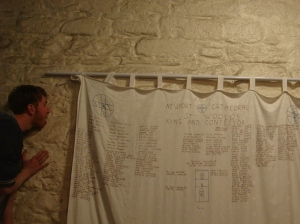
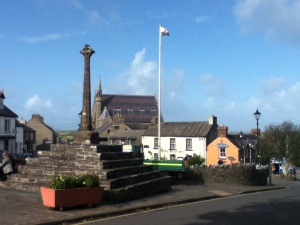


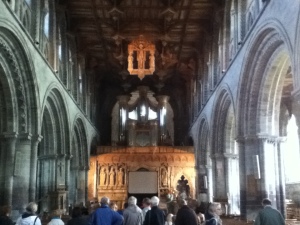
I’ve often wished for a bottle oc chloroform and a flannel myself. I loved the St David’s post.
This is my favourite post…